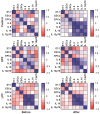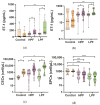Levels of Plasma Endothelin-1, Circulating Endothelial Cells, Endothelial Progenitor Cells, and Cytokines after Cardiopulmonary Bypass in Children with Congenital Heart Disease: Role of Endothelin-1 Regulation
- PMID: 39201580
- PMCID: PMC11354401
- DOI: 10.3390/ijms25168895
Levels of Plasma Endothelin-1, Circulating Endothelial Cells, Endothelial Progenitor Cells, and Cytokines after Cardiopulmonary Bypass in Children with Congenital Heart Disease: Role of Endothelin-1 Regulation
Abstract
Congenital heart disease (CHD) can be complicated by pulmonary arterial hypertension (PAH). Cardiopulmonary bypass (CPB) for corrective surgery may cause endothelial dysfunction, involving endothelin-1 (ET-1), circulating endothelial cells (CECs), and endothelial progenitor cells (EPCs). These markers can gauge disease severity, but their levels in children's peripheral blood still lack consensus for prognostic value. The aim of our study was to investigate changes in ET-1, cytokines, and the absolute numbers (Ɲ) of CECs and EPCs in children 24 h before and 48 h after CPB surgery to identify high-risk patients of complications. A cohort of 56 children was included: 41 cases with CHD-PAH (22 with high pulmonary flow and 19 with low pulmonary flow) and 15 control cases. We observed that Ɲ-CECs increased in both CHD groups and that Ɲ-EPCs decreased in the immediate post-surgical period, and there was a strong negative correlation between ET-1 and CEC before surgery, along with significant changes in ET-1, IL8, IL6, and CEC levels. Our findings support the understanding of endothelial cell precursors' role in endogenous repair and contribute to knowledge about endothelial dysfunction in CHD.
Keywords: biomarkers; cardiopulmonary bypass surgery; children; circulating endothelial cells; congenital heart disease; cytokines; endothelial progenitor cells; endothelin-1.
Conflict of interest statement
The authors declare no conflicts of interest.
Figures




Similar articles
-
Correlation between congenital heart disease complicated with pulmonary artery hypertension and circulating endothelial cells as well as endothelin-1.Int J Clin Exp Pathol. 2015 Sep 1;8(9):10743-51. eCollection 2015. Int J Clin Exp Pathol. 2015. PMID: 26617785 Free PMC article.
-
Time course of endothelin-1 and nitrate anion levels after cardiopulmonary bypass in congenital heart defects.Ann Thorac Surg. 1997 Mar;63(3):648-52. doi: 10.1016/s0003-4975(96)01055-7. Ann Thorac Surg. 1997. PMID: 9066378
-
Circulating endothelial cells: a new candidate biomarker of irreversible pulmonary hypertension secondary to congenital heart disease.Circulation. 2009 Jan 27;119(3):374-81. doi: 10.1161/CIRCULATIONAHA.108.808246. Epub 2009 Jan 12. Circulation. 2009. PMID: 19139384
-
Endothelin-1 in congenital heart disease.Pediatr Res. 2005 May;57(5 Pt 2):16R-20R. doi: 10.1203/01.PDR.0000160447.83332.13. Epub 2005 Apr 6. Pediatr Res. 2005. PMID: 15817494 Review.
-
Flow Cytometric Determination of Circulating Progenitor Cells in Patients With Pulmonary Arterial Hypertension: A Systematic Review.Pulm Circ. 2025 Mar 20;15(1):e70065. doi: 10.1002/pul2.70065. eCollection 2025 Jan. Pulm Circ. 2025. PMID: 40125448 Free PMC article. Review.
Cited by
-
Antioxidant Capacity and Therapeutic Applications of Honey: Health Benefits, Antimicrobial Activity and Food Processing Roles.Antioxidants (Basel). 2025 Aug 4;14(8):959. doi: 10.3390/antiox14080959. Antioxidants (Basel). 2025. PMID: 40867855 Free PMC article. Review.
References
-
- Su Z., Zou Z., Hay S.I., Liu Y., Li S., Chen H., Naghavi M., Zimmerman M.S., Martin G.R., Wilner L.B., et al. Global, regional, and national time trends in mortality for congenital heart disease, 1990–2019: An age-period-cohort analysis for the Global Burden of Disease 2019 study. EClinicalMedicine. 2022;43:101249. doi: 10.1016/j.eclinm.2021.101249. - DOI - PMC - PubMed
-
- Boyle E.M., Jr., Pohlman T.H., Johnson M.C., Verrier E.D. Endothelial cell injury in cardiovascular surgery: The systemic inflammatory response. Ann. Thorac. Surg. 1997;63:277–284. - PubMed
MeSH terms
Substances
Grants and funding
LinkOut - more resources
Full Text Sources
Medical

